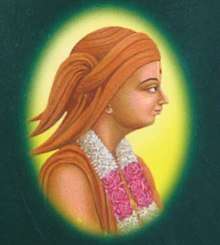Gopalanand Swami
| Gopalanand Swami | |
|---|---|
 | |
| Religion | Hinduism |
| Personal | |
| Born |
Khushal Bhatt 17 October 1781 Arvalli District's, Torda Village of Bhiloda Taluka, Gujarat, India) |
| Died |
11 October 1852 (aged 66) Vadtal, British India (present-day Gujarat, India) |
| Guru | Swaminarayan |
| Literary works | Gopalanand Swamini Vato |
| Part of a series on |
| Vaishnavism |
|---|
 |
|
Important deities |
|
Sampradayas |
|
|
| Part of a series on | ||
| Hindu philosophy | ||
|---|---|---|
 | ||
| Orthodox | ||
|
|
||
| Heterodox | ||
|
|
||
|
||
Gopalanand Swami (1781–1852) was a paramhansa of the Swaminarayan Sampraday who was ordained by Swaminarayan. He worked and guided many followers to spread the Swaminarayan Sampraday. The Original Swaminarayan Sampraday (Ahmedabad & Vadtal) believe that Gopalanand Swami is a manifestation of Akshar-Brahm also known as Mul Akshar. The scriptures too show this as evidence. In the scriptures of the Swaminarayan Sampraday it was noted that Gopalanand Swami has been mentioned a few times as the incarnation of Akshar as stated by Swaminarayan.
Biography
Born Khushal Bhatt, he was born in the Arvalli District's, Torda Village of Bhiloda Taluka, Gujarat. Torda is surrounded by mountains. His father was an audichiya brahmin, Motiram Sharma and his mother was Kushaladevi Thakar. Gopalanand Swami pursued deep study and showed great interest of grammar, Indian philosophy of Nyaya and Vedanta. Gopalanand Swami was a scholar, with knowledge in Vyakaran (grammar), Nyaya, Mimasa, Astrology etc. He was married to Adityabai and had two children Harisankar and Anupamba though he felt no attachment.[1] Swaminarayan gave diksha (the becoming of a saint in which vows such as celibacy and renunciation of all personal possessions and of all worldly duties, including family ties are taken) to Gopalanand Swami in Vadodara, Gujarat. Swaminarayan held Gopalanand Swami in very high regard and he was very learned in Ashtang yoga. Gopalanand Swami died in 1852 in Vadtal.[2]
Responsibility of the Swaminarayan Sampraday
When Swaminarayan returned to his abode (Gadhadha, year 1830), he left responsibility of the Swaminarayan Sampraday and the Acharyas in his hands and he looked after the satsang after the death of swaminarayan.[3] Further, it is said that Swaminarayan had asked Brahmanand Swami to overlook the completion of the Junagadh Temple because he knew Brahmanand Swami had powers to bring a person back to life after death. He therefore instructed Gopalanand Swami not to inform Brahmanand Swami about his death till after the cremation of his mortal remains.[2]
Sarangpur temple
Gopalanand Swami arranged for an idol of Kastabhanjan Dev Hanuman to be installed in the Sarangpur temple which is said to have come alive and moved when installed by him.[4] He wanted to see the idol of Hanuman interactive.
Works
Source: [5]
Sanskrit Books
- Vivekdeep
- Vishnuyaag Paddhati
- Pujavidhi
- Bhakti Siddhi
- Haribhakta Namavali
- Brahmasutrarthdeep
- Ishadi Upanishad Bhashya
- Shreemad Bhagwad Geeta Bhashya
- Commentary on Second Canto of Shreemad Bhagwat (Sukabhipray Bodhini Tika)
- Dasham Skandh Goodharth Bodhini Tika
- Ekadash Skandh Krushnabhipray Bodhini Tika
- Ved Stuti Shrutyarth Bodhini Tika and Anvayarth Bodhini Tika
- Shandilya Sutra Bhakti Prakashika Tika etc.
Vernacular Books
- Varta Vivek
- Advait Khandan
- Marathi Translation of Shikshapatri
- Updeshi Vartao
- Puja Paddhati na Pana
- Bhaktisiddhi Bhashantar (Translation of Bhaktisiddhi)
- Sampraday Pradeep
Notes
- ↑ http://www.swaminarayanwales.org.uk/?ID=Gopalanand_Swami
- 1 2 Nand Santos - Gopalanand Swami
- ↑ Williams 2001, pp. 35, 36
- ↑ Williams 2001, pp. 128
- ↑ Shee Gopalanand Swami ni Vato. Sardhar: Shree Swaminarayan Mandir Sardhar. 2008. p. 27.
References
- Williams, Raymond (2001), Introduction to Swaminarayan Hinduism, Cambridge University Press, ISBN 978-0-52165-422-7

